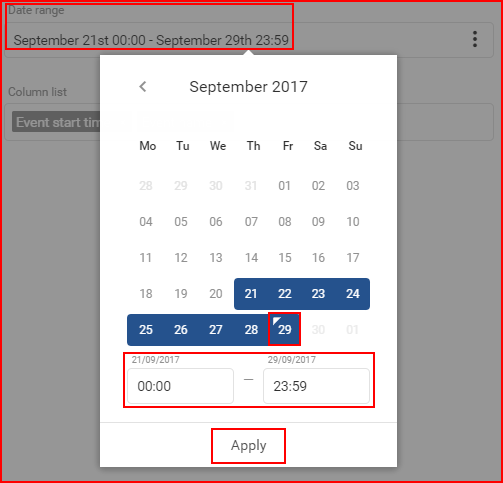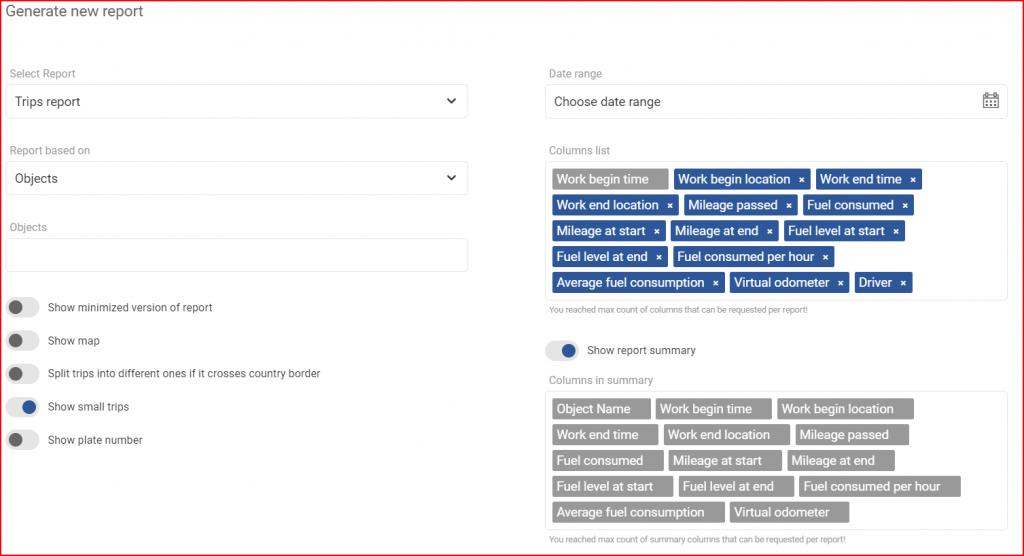Trips report – is focused mainly on generating details of trips, such as where the trip began, where it ended, how long it lasted, what distance was passed during the trip and so on. The first thing the user must select is the date range, for which this report will be generated.
Date range – to select a date the user must click the “Choose date range” which will open the calendar panel. The calendar panel is identical in all of the FMS. To select a begin/end date the user must simply click the desired date and then click the opposite date. The selected days will be highlighted in blue. The current day is highlighted by a small blue triangle on the top left side of that day. If the current day is selected (highlighted), the triangle will be inverted to white. To select a preferred date start by clicking on the end or beginning date (there is no priority in choosing) and afterwards click the opposite (end/begin) date. Afterwards the user can specify from which hour of the begin date until which hour of the end date to display the history. To apply the changes the “Apply” button must be clicked, otherwise the changes will not be saved.
The minimal date period is one day. To select one day simply double click the left mouse button on the desired day to select it. Afterwards the user must select based on what will the report be generated on.
Report based on– this setting defines the main target of the report. There are two available options:
- Drivers;
- Objects.
What exactly this does is, that the generated report will display information (parameters: trip distance, work begin location, etc.) for the selected target (Drivers or Objects). So if Objects are selected, then the report will display information for specific selected objects.
Objects/Drivers – (Depends on the selection in the “Report based on” option) this allows the user to choose for which objects/drivers the report will be generated.
If Objects are selected, the list will also contain groups of objects. The user can select a whole group by marking the checkbox before the group, or click the “+” button to expand the group and see which objects are in the group. To collapse the group, the user must click the “-” button. Individual objects can be selected from a group. It is important to note, if an object that is present in several groups is selected, it will be highlighted in every group as shown below in the picture. If a whole group is selected, the checkbox will be blue with a white tick. If only a part of the group is selected, the group will have a blue square in the checkbox. (shown in the picture below). The user can also use the search, to quickly go through large list of objects and groups. All groups can be selected/deselected by ticking the checkbox next to “Select all groups”. The number of selected objects and total objects is displayed at the upper right corner of the list.
If Drivers is selected, drivers will be displayed in the drop-down list. To select a driver, the user has to mark the checkbox next to the driver. Marking the checkbox next to “Select all” will select/deselect all drivers. The list is automatically updated with each symbol typed in the search bar. The number of selected drivers and total drivers is displayed at the upper right corner of the list.
After objects/drivers are selected, the user must select parameters in the Column list. This report will include the following parameters are selected by default:
- Work begin time – time of first ignition on event, cannot be unselected;
- Work begin location – location where the first ignition on event was triggered, can be unselected;
- Work end time – time of last ignition of event, can be unselected;
- Work end location – location where the last ignition off event was triggered, can be unselected;
- Mileage passed – mileage passed during the trip.
- Fuel consumed – total amount of fuel used during the trip;
- Mileage at start – mileage, when the trip began;
- Mileage at end – mileage, when the trip ended;
- Fuel level at start – total amount of fuel at the start of the trip;
- Fuel level at end – total amount of fuel at the end of the trip;
- Fuel consumed per hour – fuel consumption per hour for the trip;
- Average fuel consumption – fuel consumed per 100km;
- Virtual odometer – virtual odometer mileage of trip, calculated from the difference from the trip beginning and trip end.
- Driver – driver name;
Optional parameters that can be selected:
- Fuel consumed while idling – total amount of fuel used while the vehicle was idling;
- Idling duration – duration of vehicle in idling state;
- Mileage and Virtual Odometer distance – the difference between the mileage and virtual odometer values;
- No. – adds a numbering column for the trips;
- Notes – empty column, for user information;
- Speed average – the average speed throughout the trip;
- Speed maximum – the maximum speed throughout the trip;
- Stop duration – total time during which the vehicle was standing still, can be unselected;
- Trip type – indicates the trip type, can be: business, work, private, none;
- Working duration – total time duration which the vehicle was moving, can be unselected;
- DIN1-4 Working time – the total working time of a selected DIN. 4 separate parameters can be selected for each DIN.
After selecting the parameters in the column list, the user can enable or disable the following additional settings:
Show minimized version of report – disabled by default. Enabling this option will merge all trip data for an object/driver into a single summary and details table, instead of separate tables for each day selected in the report. Enabling this option will also enable the Report summary option and disable the Show map option.
Show map – enabled by default, this option will include a map in the report, with all drain/refuel events marked on it.
Split trip into different ones if it crosses country border – disabled by default, if enabled, a trip passing through a country border will be split at the point of crossing a border, thus separating it into two trips, one before the border and one after.
Show small trips – disabled by default, if enabled will include trips in the report that are shorter than 50 meters of total travel distance.
Show plate number – disabled by default, this option will include the plate number of the vehicle in the report.
Show report summary – enabled by default, this option will include a summary section in the report. This will summarize all information in the report. After the report summary selection, the user can select the splitting interval.
To finalize and generate the report, the user must click the “Generate” button. To cancel the creation of a report the user must either click the “Cancel” button or click anywhere outside the “Generate new report” window.




